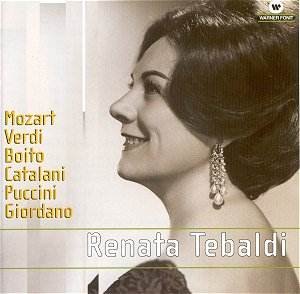Renata Tebaldi was a faithful Decca artist for
practically her entire career. She did, however, in her earliest
days, record two recitals for Cetra, both drawn on here, and take
part in that company’s Andrea Chénier, which I have already
reviewed for the site and from which we have two extracts to complete
the compilation.
Since she was a very consistent artist there
may be no pressing reason for non-specialist listeners to get
to know her through these passable but elderly-sounding recordings
rather than later Decca material, some of it in stereo. She left
no youthful indiscretions, but nor does she reveal special qualities
in her early years that were lost later. The aficionado will,
however, find a lot of interest in comparing these with her later
versions.
A comparison of this performance of "Sì,
mi chiamano Mimì" with those in her two complete Bohèmes,
under Erede in 1951 and Serafin in 1959, suggests a gradual refining,
a leaving behind of sobs and gulps and similar tricks of the trade,
a tighter control over portamento, and in general an increasingly
"pure" art. It is interesting to note that this "voice
of an angel", as it was dubbed, actually started out with
a darker, heavier timbre – the reverse of what later happened
with Scotto and Freni. In the three versions of "Donde lieta
uscì" the differences are greater and show her responding
to the various conductors. In the case of a recital record, a
conductor is not expected to be the protagonist, so it may be
no disrespect to Nino Sanzogno to say that he simply follows along.
Nothing gets in the way of our enjoyment of a young voice in its
first stage of beauty. All the same, it is striking how much point
there is to everything under Erede, an urgent, passionate reading.
While Serafin bathes everything under the rosy glow of memory,
a touchingly restrained performance made possible by Tebaldi’s
exquisite control of her vocal resources. I wouldn’t like to say
which of the two I prefer, and it’s fascinating that both should
come from the same singer.
So take this disc as a snapshot of the voice
in its first glory. As regards repertoire, most of the operas
from which these arias come were recorded complete later on –
perhaps a little too much later on in the case of "La Wally".
She made famous recordings of "Aida" and "Otello"
under Karajan (and earlier ones under Erede) but – like Maria
Callas – she made only one official recording of "La Traviata",
a not very satisfactory affair under Molinari-Pradelli. (Another
curious parallel is that live performances by both singers have
survived directed by Giulini). She certainly brings the right
pathos to the aria here. The piece from "Aida" shows
that right from the start her top C was not her greatest point,
and her top notes actually came more easily over the following
decade. The one opera here which she did not record was "Le
Nozze di Figaro". She took a few Mozartian roles during her
career and surely the Countess, not Susanna, would have been her
part in Figaro. Predictably, she is too heavy.
Obviously, all recordings of a great singer are
necessary to her fans. Those who approach her for the first time
will certainly get a good idea of her qualities even at this early
stage, but I do recommend them to hear her more mature work first.
As though to emphasise that this issue is primarily one for fans,
the arias have been arranged neatly in order of recording, when
listening logic might have placed the May 1950 sessions before
those of March. Waffly notes and texts but no translations.
Christopher Howell

